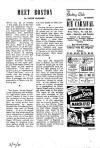| Home
Page Meet
Boston Menu Index
This may be of interest this week, due to the fact that the traditional "haunting" is on March 16—there is a "haunted house" legend associated with downtown Boston. This refers to the former Province House, the headquarters of Massachusetts government before the Revolution. According to this story, there is a ghost parade there, of all the colonial governors of Massachusetts, every year on the evening of March 16, starting when the clock on the Old South Church strikes 11. Whether this applies to the modern Province Building, standing on the same spot, at 333 Washington Street, we may leave to the reader's imagination. This story is reported in Hawthorne's "Twice-Told Tales," which claims that the parade of spectres started in 1776, when it presaged the British evacuation of Boston the following day. * The Salem "Witch House" is not connected with witches. It's legitimate claim to historical interest is that it was the residence of the famous preacher, Roger Williams, who, on being exiled from Massachusetts for heresy, founded the Providence Plantations (now part of Rhode Island). It would almost seem that the house would be more interesting if presented to the visitor in its true light; namely, as the house in which Roger Williams worked out his ideas of religious tolerance before going out and founding the first community ever based on that principle. * Anyone caring to see what sort of decorative effect can be gotten out of just numbers should look down the first block of Tyler Street―the block between Kneeland and Beach―after dark. Most of the Chinese restaurants in that block have put their street numbers in neon lights, isolated and large. The effect of the combination of figures is, to say the least, quite unusual. Darn clever, these Chinese. * Not only did vaudeville start in Boston, but the first vaudeville house got its first serious competition here before the idea spread out of Boston. Shortly after this new form of entertainment was inaugurated, the Boston Music Hall, a place originally used for actual musical performances, shifted to vaudeville. It was located in the center of a block, connected by a passageway to Washington Street and by alleys to the other sides of the block. The name of the building was later changed to Orpheum, also a reminder of its musical origin. Under that name it is still operating, now as a movie theatre. The alley on the Winter Street side is still called Music Hall Place, though that entrance now leads to the Gilchrist store, which has spread into the basement of the Music Hall building. At present vaudeville is called "music halls" in England―apparently a testimonial to the Boston origin of this type of entertainment.
|
